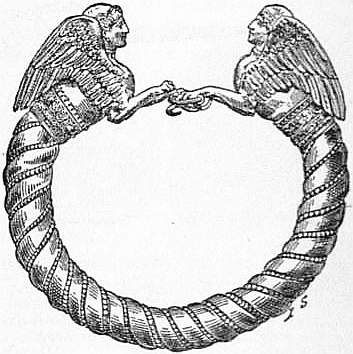Bracelet, or Armlet, a personal ornament for the arm or wrist, made of different materials, according to the fashion of the age and the rank of the wearer. The word is the French bracelet, a diminutive of bracel, from brac(c)hiale, formed from the Latin bracchium, the arm, on which it was usually worn. By the Romans it was called armilla, brachiale, occabus; and in the middle ages bauga, armispatha.
 |
| From La Grande Encyclopédie. Fig. 1.—Egyptian Bracelet, Louvre. |
In the Bible there are three different words which the authorized version renders by “bracelet.” These are—(1) הרעצא ’eş‘adah, which occurs in Num. xxxi. 50, 2 Sam. i. 10, and which being used with reference to men only, may be taken to be the armlet; (2) דימצ şamīd, which is found in Gen. xxiv. 22, Num. xxxi. 50, Ezek. xvi. 11;—where these two words occur together (as in Num. xxxi. 50) the first is rendered by “chain,” and the second by “bracelet”; (3) תורש sheroth, which occurs only in Isa. iii. 19. The first probably meant armlets worn by men; the second, bracelets worn by women and sometimes by men; and the third a peculiar bracelet of chain-work worn only by women. In 2 Sam. i. 10 the first word denotes the royal ornament which the Amalekite took from the arm of the dead Saul, and brought with the other regalia to David. There is little question that this was such a distinguishing band of jewelled metal as we still find worn as a mark of royalty from the Tigris to the Ganges. The Egyptian kings are represented with armlets, which were also worn by the Egyptian women. These, however, are not jewelled, but of plain or enamelled metal, as was in all likelihood the case among the Hebrews.
In modern times the most celebrated armlets are those which form part of the regalia of the Persian kings and formerly belonged to the Mogul emperors of India, being part of the spoil carried to Persia from Delhi by Nadir Shah in 1739. These ornaments are of dazzling splendour, and the jewels in them are of such large size and immense value that the pair have been reckoned to be worth a million sterling. The principal stone of the right armlet is famous in the East under the name of the Darya-i-nur, “sea (or river) of light.” It weighs 186 carats, and is considered the diamond of finest lustre in the world. The principal jewel of the left armlet, although of somewhat inferior size (146 carats) and value, is renowned as the Tāj-e-mah, “crown of the moon.” The imperial armlets, generally set with jewels, may also be observed in most of the portraits of the Indian emperors.
Bracelets have at all times been much in use among barbaric nations, and the women frequently wear several on the same arm. The finer kinds are of mother-of-pearl, fine gold or silver; others of less value are made of plated steel, horn, brass, copper, beads, &c. Chinese bracelets are sometimes cut out of single pieces of jade.
 |
| From La Grande Encyclopédie. |
| Fig. 2.—Greek Bracelet, Hermitage. |
This species of personal ornament has been exceedingly common in Europe from prehistoric times onward. The bracelets of the Bronze Age were of either gold or bronze, silver being then unknown. In shape they were oval and penannular with expanding or trumpet-shaped ends, having an opening between them of about half an inch to enable them to be easily slipped over the wrist. Those of gold were generally plain, hammered rods, bent to the requisite shape, but those of bronze were often chased with decorative designs. Some forms of spiral armlets of bronze, peculiar to Germany and Scandinavia, covered the whole fore-arm, and were doubtless intended as much for defence against a sword-stroke as for ornament. Among the nations of classical antiquity, bracelets were worn by both sexes of the Etruscans; by women only among the Greeks, except in orientalized communities. Among the Romans they were worn by women only as a rule, but they are also recorded to have been used during the empire by nouveaux riches, and by some of the emperors. It should also be mentioned that bracelets were conferred as a military decoration in the field.
The bracelets of the Greeks are of two leading types, both of which were also familiar to the Assyrians. The one class were in the form of coiled spirals, usually in the form of snakes, a term which Pollux gives as a synonym for bracelet. The other class were stiff penannular hoops, capable of being slightly opened. In such examples the terminals are finely finished as rams’ heads, lions’ heads, or (as in the accompanying figure from a bracelet found at Kuloba) as enamelled sphinxes. In late Etruscan art the bracelet may be formed of consecutive panels, as often in modern jewelry.
 |
| From La Grande Encydopédie. Fig. 3.—Etruscan Bracelet, Louvre. |
The spiral forms were common in the Iron Age of northern Europe, while silver bracelets of great elegance, formed of plaited and intertwisted strands of silver wire, and plain penannular hoops, round or lozenge-shaped in section and tapering to the extremities, became common towards the close of the pagan period. The late Celtic period in Britain was characterized by serpent-shaped bracelets and massive armlets, with projecting ornaments of solid bronze and perforations filled with enamel. In the middle ages bracelets were much less commonly used in Europe, but the custom has continued, to prevail among Eastern nations to the present time, and many of the types that were common in Europe in prehistoric times are still worn in central Asia.
A treatise, De Armillis Veterum, by Thomas Bartholinus, was published at Amsterdam in 1676.


